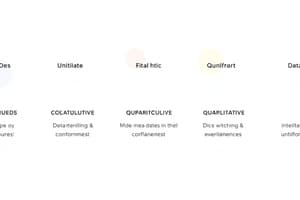Podcast
Questions and Answers
What is the primary focus of a depth interview?
What is the primary focus of a depth interview?
- To explore individual perspectives on specific topics (correct)
- To gather quantitative data from a large sample size
- To conduct brief interviews with many respondents
- To perform structured surveys with predefined questions
In what manner is a depth interview typically conducted?
In what manner is a depth interview typically conducted?
- As a quick telephone interview
- By using a focus group of respondents
- As an intensive one-on-one face-to-face discussion (correct)
- Through automated online surveys
Which aspect best describes the nature of respondents in a depth interview?
Which aspect best describes the nature of respondents in a depth interview?
- They represent a large demographic segment.
- They are solely anonymous participants required to provide quick feedback.
- They are selected to provide varied quantitative data.
- They are a small number of individuals providing detailed insights. (correct)
What is a common misconception regarding the process of depth interviewing?
What is a common misconception regarding the process of depth interviewing?
What is a significant characteristic of depth interviews?
What is a significant characteristic of depth interviews?
What is the primary goal of data validation in the data preparation process?
What is the primary goal of data validation in the data preparation process?
Which of the following best describes what happens during data validation?
Which of the following best describes what happens during data validation?
During the data preparation phase, validation primarily focuses on which aspect?
During the data preparation phase, validation primarily focuses on which aspect?
What would most likely NOT be an outcome of performing data validation?
What would most likely NOT be an outcome of performing data validation?
Which aspect is NOT typically involved in the data validation process?
Which aspect is NOT typically involved in the data validation process?
Which of the following best defines a database?
Which of the following best defines a database?
Which of these software is NOT listed as a major statistical data analysis tool in 2024?
Which of these software is NOT listed as a major statistical data analysis tool in 2024?
What is the primary feature of a database?
What is the primary feature of a database?
Which software is primarily recognized for statistical analysis in social sciences?
Which software is primarily recognized for statistical analysis in social sciences?
In the context of databases, which statement is false?
In the context of databases, which statement is false?
Flashcards
Depth Interview
Depth Interview
An in-depth interview method used to explore respondent perspectives on targeted ideas or programs.
Individual Interviews
Individual Interviews
One-on-one conversations used to gather information in depth interviews.
Small Number of Respondents
Small Number of Respondents
A limited number of people interviewed in depth interviews.
Respondent Perspectives
Respondent Perspectives
Signup and view all the flashcards
Targeted Ideas/Programs
Targeted Ideas/Programs
Signup and view all the flashcards
Data Validation
Data Validation
Signup and view all the flashcards
Raw Data
Raw Data
Signup and view all the flashcards
Data Errors
Data Errors
Signup and view all the flashcards
Data Correction
Data Correction
Signup and view all the flashcards
Data Preparation
Data Preparation
Signup and view all the flashcards
Database
Database
Signup and view all the flashcards
Statistical Package
Statistical Package
Signup and view all the flashcards
What is Microsoft Excel used for?
What is Microsoft Excel used for?
Signup and view all the flashcards
What is Matlab used for?
What is Matlab used for?
Signup and view all the flashcards
What is SPSS used for?
What is SPSS used for?
Signup and view all the flashcards
Study Notes
Data
- Data are individual facts, observations, statistics, characters, symbols, images, numbers
- Data without context lack meaning and are difficult to understand. They are often called "raw data".
- Research data can be classified as quantitative or qualitative.
Quantitative Data
- Quantitative data can be counted or expressed numerically.
Qualitative Data
- Qualitative data are descriptive and lack numerical values.
Types of Data
- Primary data are generated by a researcher for a specific purpose and collected directly from subjects. (First-hand information)
- Secondary data are already available and collected from other sources.
Data Collection Methods
- Data collection is essential to research, as conclusions are based on the data.
- Common methods include:
- Observation
- Questionnaire
- Interview
- Surveys
- Experimental devices
1- Observation
- Observational research (field research) involves directly observing phenomena in natural settings.
- Types include:
- Non-controlled, participant observation: Researcher becomes a member of the group under study. (Disadvantage: Researcher may lose objectivity)
- Non-controlled, non-participant observation: Researcher observes the group from a distance.
- Systematic, controlled observation: Researcher pre-determines variables (location, time, participants, tools), and controls the study.
2- Questionnaire
- A questionnaire is a series of written questions given to subjects.
- Structured (closed) questionnaire: Closed questions have predetermined, rigid and clear answer options.
- Unstructured (open) questionnaire: Open questions elicit view points and opinions.
3- Interview
- Interviews are conversations with a purpose, more than just exchanging information.
- Types include:
- Non-directive
- Directive
- Repeated
- Focused
- Depth
4- Surveys
- Surveys involve subjects responding to statements or questions in questionnaires or interviews, often directed at populations.
- Typically a sample representing the whole is studied. Random sampling ensured representativeness.
Information
- Information is processed data, structured, and presented to make it meaningful and useful.
- Steps in data processing:
- Collection
- Preparation
- Input
- Processing
- Output
- Storage
Data Processing Operations
- Data in raw form is not useful.
- Data processing transforms raw data into usable information.
- Operations include:
- Data collection: Methodology of gathering data
- Data preparation (validation): Checking collected data for errors and correcting them.
- Sorting: Ordering data (descriptive or numerical).
- Input: Converting sorted data into a machine-readable format.
- Processing: Analyzing data.
- Manual data analysis: Suitable for small datasets, but time-consuming.
- Computer-based data analysis: Requires knowledge of appropriate software and statistics.
- Output/Interpretation: Presenting data in a usable format for non-data scientists.
- Storage: Saving data and metadata for future use
Types of Data Processing
- Batch processing: Collecting and processing data in batches, used for large amounts of data.
- Real-time processing: Processing data within seconds when input is given (e.g., ATM).
- Online processing: Data fed to the CPU as soon as available (e.g., barcode scanning).
- Time-sharing: Allocating computer resources to multiple users simultaneously.
Statistical Analysis and Software
- Statistical analysis is used to collect, analyze large amounts of data to identify patterns and trends.
- Descriptive analysis: Summarizes data using measures like mean, median, mode, range, standard deviation etc.
- Inferential statistics: Drawing conclusions about a population from samples; often involves hypothesis testing and regression analysis.
- Associative/relative statistics: Identifying meaningful interrelationships between data, (e.g. relationship between salt intake and blood pressure).
- Major statistical analysis software include SPSS, Microsoft Excel, Matlab, Minitab, OriginPro, GraphPad Prism.
Database
- A database is a collection of organized information for easy access, management, and updation.
- Types of databases:
- Relational
- Document-oriented
- Graph
- Hypertext
- Operational
- Distributed
- Flat file
Relational Database
- A relational database is a collection of tables containing data items.
- Tables contain rows (tuples) and columns (attributes).
Document-Oriented Database
- A type of nonrelational database designed to store data in JSON-like documents.
Graph Database
- Uses graph structures (nodes, edges, properties).
Hypertext Database
- Database system linking objects (text, images, programs)
Operational Database
- Designed for real-time data definition, modification, retrieval and management in organizations.
Distributed Database
- Portions of the database are stored on multiple computers in a network.
Flat File Database
- Stores data in a single table.
- Typically in plain text format, with fields separated by commas or tabs. Its ideal for small datasets.
Data & Information & Knowledge
- Knowledge combines information, experience, and insight.
- Information answers "who, when, where"; knowledge answers "why, how."
Basis for Information & Knowledge Comparison
- Meaning: Information is systematically presented data; knowledge is gained through experience.
- Combination: Data and context; Information, experience, and intuition.
- Processing: Improves representation; Increases awareness.
- Transfer: Easily transferable, Requires learning.
- Prediction: Information alone is insufficient for prediction; prediction possible with knowledge.
- One in other: All knowledge is information, but not all information is knowledge.
Knowledge Acquiring Sources
- Unscientific:
- Empiricism: Knowledge gained through senses.
- Trial and error: Knowledge from practical experience.
- Tradition: Knowledge passed down through generations.
- Tenacity: Believing something true simply because it's heard repeatedly.
- Rationalism: Knowledge gained through logical reasoning.
- Authority: Knowledge from respected figures.
- Scientific: Knowledge based on empirical evidence.
- Objectivity
- Verifiability/Measurability
- Reliability
Meaning of Research
- Research is an investigation to find solutions to a problem or discover new knowledge and information.
- "RE" means "again, anew, or over again," and "SEARCH" means "to examine closely, carefully, to test or to probe."
Types of Research
- Application:
- Pure research: Systematic study for a better understanding of phenomena without immediate application.
- Applied research: Applying Pure Research outcomes (theories) to real-world situations.
- Objectives:
- Exploratory research: Studying areas not well understood.
- Descriptive research: Describing characteristics of a problem, phenomenon, or group.
- Correlational research: Identifying relationships between variables.
- Explanatory research: Explaining why something occurs.
- Inquiry mode:
- Qualitative research: Unstructured approach using soft data (impressions, words, symbols).
- Quantitative research: Structured approach measuring hard data.
Studying That Suits You
Use AI to generate personalized quizzes and flashcards to suit your learning preferences.




